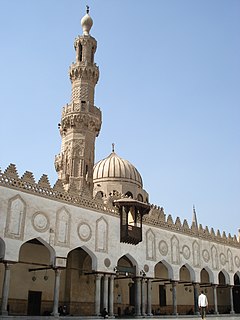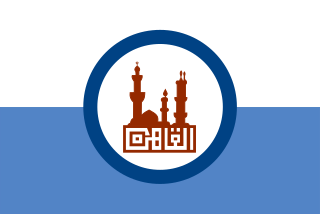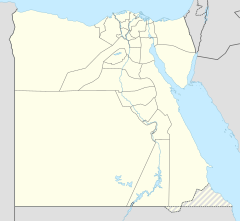
The Mosque of al-Hakim, nicknamed al-Anwar, is a major Islamic religious site in Cairo, Egypt. It is named after Al-Hakim bi-Amr Allah (985–1021), the sixth Fatimid caliph and 16th Ismaili Imam. This mosque originally started being built by al-Aziz, the son of Mu'izz, and the father of al Hakim, in 990 A.D. It was named after Al Hakim because he has finished it.

Al-Azhar University is a university in Cairo, Egypt. Associated with Al-Azhar Mosque in Islamic Cairo, it is Egypt's oldest degree-granting university and is renowned as the most prestigious university for Sunni Islamic learning. In addition to higher education, Al-Azhar oversees a national network of schools with approximately two million students. As of 1996, over 4,000 teaching institutes in Egypt were affiliated with the University.

The Mosque-Madrassa of Sultan Hassan is a monumental mosque and madrassa located in the historic district of Cairo, Egypt. It was built between 1356 and 1363 during the Bahri Mamluk period, commissioned by Sultan an-Nasir Hasan. The mosque was considered remarkable for its massive size and innovative architectural components, and is still considered one of the most impressive historic monuments in Cairo today.

Islamic Cairo, also called Historic Cairo or Medieval Cairo, refers generically to the historic areas of Cairo, Egypt, that existed before the city's modern expansion during the 19th and 20th centuries; particularly the central parts around the old walled city and around the Citadel of Cairo. The name "Islamic" Cairo refers not to a greater prominence of Muslims in the area but rather to the city's rich history and heritage since its foundation in the early period of Islam, while distinguishing it from with the nearby Ancient Egyptian sites of Giza and Memphis. This area holds one of the largest and densest concentrations of historic architecture in the Islamic world. It is characterized by hundreds of mosques, tombs, madrasas, mansions, caravanserais, and fortifications dating from throughout the Islamic era of Egypt. In 1979, the United Nations Educational, Scientific and Cultural Organization (UNESCO) proclaimed Historic Cairo a World Cultural Heritage site, as "one of the world's oldest Islamic cities, with its famous mosques, madrasas, hammams and fountains" and "the new centre of the Islamic world, reaching its golden age in the 14th century."

Sohag, also spelled as Sawhāj, Suhag and Suhaj, is a city on the west bank of the Nile in Egypt. It has been the capital of Sohag Governorate since 1960, before which the capital was Girga and the name of the governorate was Girga Governorate. It also included Esna Governorate.

Khan el-Khalili is a famous bazaar and souq in the historic center of Cairo, Egypt. Established as a center of trade in the Mamluk era and named for one of its several historic caravanserais, the bazaar district has since become one of Cairo's main attractions for tourists and Egyptians alike. It is also home to many Egyptian artisans and workshops involved in the production of traditional crafts and souvenirs.

The Great Mosque of Muhammad Ali Pasha or Alabaster Mosque is a mosque situated in the Citadel of Cairo in Egypt and was commissioned by Muhammad Ali Pasha between 1830 and 1848.

The Mohammad Al-Amin Mosque, also referred to as the Blue Mosque, is a Sunni Muslim mosque located in downtown Beirut, Lebanon.

Tourism is one of the leading sources of income, crucial to Egypt's economy. At its peak in 2010 the sector employed about 12% of workforce of Egypt serving approximately 14.7 million visitors Egypt, and providing revenues of nearly $12.5 billion. as well as contributing more than 11% of GDP and 14.4% of foreign currency revenues.

Sabil-Kuttab of Katkhuda is a building from the old part of Islamic Cairo, Egypt, comprising a public fountain or sabil, an elementary Quran school or kuttab, and an adjacent residential wing. A prime example of Medieval Egyptian architecture, it was built in 1744 by a pioneer Egyptian architect, Katkhuda of Egypt.

Al-jāmiʿ al-aqmar, or al-Aqmar Mosque, was built in Cairo, Egypt, as a neighborhood mosque by the Fatimid vizier al-Ma’mun al-Bata’ihi in 1125-6 CE. Similarly to the mosque of al-Azhar (970) and the mosque of al-Hakim (990-1013), formerly named al-Anwar, the name of the al-Aqmar mosque is an epithet of the patron in connection with light. The mosque is situated on what was once the main avenue and ceremonial heart of Cairo, in the immediate neighborhood of the Fatimid caliphal palaces, known today as Muʿizz Street.

Al-Azhar Mosque, known simply in Egypt as al-Azhar, is an Egyptian mosque in Islamic Cairo. Al-Mu'izz li-Din Allah of the Fatimid dynasty commissioned its construction for the newly established capital city in 970. Its name is usually thought to derive from az-Zahrāʾ, a title given to Fatimah. It was the first mosque established in Cairo, a city that has since gained the nickname "the City of a Thousand Minarets".

The Sultan Al-Ghuri Complex or Funerary complex of Sultan al-Ghuri, also known as al-Ghuriya, is a monumental Islamic religious and funerary complex built by Sultan Qansuh al-Ghuri between 1503 and 1505 CE. The complex consists of two major buildings facing each other on al-Mu'izz li-Din Allah street, in the Fahhamin Quarter, in the middle of the historic part of Cairo, Egypt. The eastern side of the complex includes the Sultan's mausoleum, a khanqah, a sabil, and a kuttab, while the western side of the complex is a mosque and madrasa. Today the mosque-madrasa is still open as a mosque while the khanqah-mausoleum is open to visitors as a historic site.
The following is a timeline of the history of the city of Cairo, Egypt.

The Fatimid architecture that developed in the Fatimid Caliphate (909–1167 CE) of North Africa combined elements of eastern and western architecture, drawing on Abbasid architecture, Byzantine, Ancient Egyptian, Coptic architecture and North African traditions; it bridged early Islamic styles and the medieval architecture of the Mamluks of Egypt, introducing many innovations.

The Seven Mosques or Sab'u Masajid is a complex of six small historic and often visited mosques in the city of Medina, Saudi Arabia. The complex consists of six mosques in spite of the name "Sab'ah" means "seven", because it included the Masjid al-Qiblatayn originally. Although the mosque is often visited by pilgrims, Sunni sources claim that there are no accounts in the order from the Islamic prophet Muhammad or in Sharia regarding the virtue of visiting these mosques. As a result, religious police have been stationed at the mosques visited by Shias. Prominent Shia sites have been demolished as well.

Amir Khayrbak Funerary Complex, Mosque-Madrasa of Al-Amir Khair Bak or Khayrbak Mosque is a religious complex at Bab al-Wazir street, Islamic Cairo, Egypt. It originally consisted of a mausoleum established by the Ottoman governor of Egypt Khayr Bak in 1502 CE. Later he added a madrasa and a mosque, and annexed the adjacent Amir Alin Aq Palace which was used by him as residence. On the surrounding area, there is Citadel of Cairo located on the southeast, Amir Alin Aq Palace on the southwest, Aqsunqur Mosque on the northeast side. It is one of many Circassian (Burji) style Mamluk architectures built during the Middle Ages.

The following outline is provided as an overview of and topical guide to Cairo:

The Mosque of Abu al-Hassan is a historic neighbourhood mosque in Fes el-Bali, the old medina of Fes, Morocco. It is located on Tala'a Seghira street, near the Bou Inania Madrasa.





















